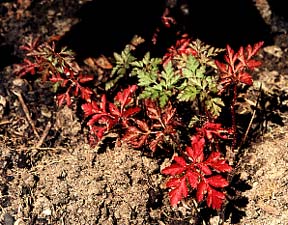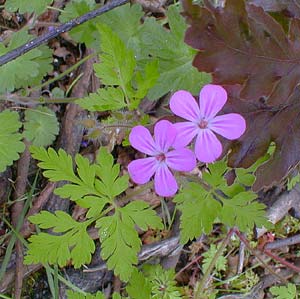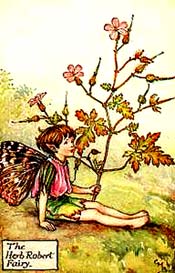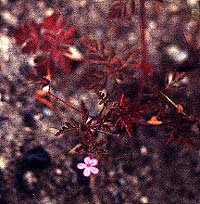 Herb Robert & the Fairy Folk
Herb Robert & the Fairy Folk
"Sweet maids of honor, woodland elves!
Frail flowers that arrive with the cuckoo,
Pale lilac, hyacinth purple of hue,
And the little pink geranium,
All smil'd & nodded to see me come."
-Roden Berkeley Wriothesley Noel
(1834-1894)
(1834-1894)
Herb Robert (Geranium robertianum), sometimes called Fox Geranium, is a wild geranium with very finely cut fern-like leaves which are stiffer than most crane's-bills & have the exciting feature of leaves that are bright red to bronze especially if grown from seeds in the sun.
In sunny spots with periodic dryness the ruddy colors can be quite amazing. But when grown in shadier or moister locations, new leaves will be green until autumn, & the color will persist on old leaves through early winter. The stems will be red whether grown in sun or in shade.
Herb Robert has naturalized in many regions of Canada & the United States. It is adaptable to many environments in either dry rocky soil or damp humusy earth, in sun or in shade, in cold environments or warm. Because the leaves if grown in a dry sunny location get so extremely red, that's where I think it looks best, but the larger denser more persistently flowering shade-specimens are also gorgeous. It's appearance in sun vs shade, damp vs dry, can be so varied as to scarsely seem like the same species.
In much of its natural & its conquered northern range, it is an easily self-seeding annual, but here on Puget Sound it is an evergreen or semi-evergreen perennial. In some parts of the country it has proven to be invasive, including areas of Eastern Washington & along the Columbia River. But here in Kitsap County, it seems to be restricted to dryish roadside areas, whereas the introduced wild geranium which has spread to every corner of the county is the Dove's-foot Crane's-bill.
Herb Robert is sometimes called "Stinky Bob" since it can give off a musky odor if the leaves are crushed or if clumps of it are dug up. It doesn't stink if left unmolested.
 Herb Robert has in fact well over 100 names in England alone, including Red Robin, Dragonsblood, Red Shanks, while the smaller closely related G. purpureum is most frequently called Little Robin. That this crane's-bill geranium is by turns personified as Robert or Bob, then as Robin, relates to the plant's attendant fairy lore.
Herb Robert has in fact well over 100 names in England alone, including Red Robin, Dragonsblood, Red Shanks, while the smaller closely related G. purpureum is most frequently called Little Robin. That this crane's-bill geranium is by turns personified as Robert or Bob, then as Robin, relates to the plant's attendant fairy lore.The alternate name "Fox Geranium" is suggestive of the Red Fox, but the suggestion deceives; it is an intentionally punning corruption of "Folks," which is an allusion to the fairy folk. It was thought unlucky to speak of the fairies, as they would overhear, & if they felt criticized in any manner, they would take revenge. So if spoken of at all they would be called "the fair folk" not because they were known to be fair or just (they were quite the opposite), but in order to appease them; & if speaking of the horrible goblin Puck, it was the rule to call him Robin Goodfellow, though he was very far from good.
Robin Goodfellow is also known as Pug, Friar Rush, but most popularly as Puck, & is frequently demonic. One must speak of Robin Goodfellow in hushed tones lest he overhear, & by alluding to him as Robert it was hoped he would not know he was spoken of at all, just as speaking of Puck's race broadly as "Foxes" was hoped to keep the Fair Folk from taking notice. Really the name Herb Robert is so old that it is impossible to say which piece of folklore gave rise to the plant's name, or which folklore arose later to explain the plant's name.
 Hob, Robert, Robin, or Rupert are more or less the same name, & a few speculate that Herb Robert is named for Robin Hood who is vaguely like Puck in that he dwelt in the forest & brought ill luck to those who deserved ill luck, good luck to whoever he supported. Another of Herb Robert's regional names was indeed Robin Hood, so there was certainly some blending of the lore.
Hob, Robert, Robin, or Rupert are more or less the same name, & a few speculate that Herb Robert is named for Robin Hood who is vaguely like Puck in that he dwelt in the forest & brought ill luck to those who deserved ill luck, good luck to whoever he supported. Another of Herb Robert's regional names was indeed Robin Hood, so there was certainly some blending of the lore.Herb Robert was on the continent associated with the German version of Hob Goblin, by name Knecht Rupert or Knecht Ruprecht, regarded as a dark form of Saint Nicholas. While St. Nick brings good children gifts on Christmas, Knecht Rupert, or Black Peter, leaves bad children a lump of coal. In the scariest version he snatches children in his sack, so that they were never again to be seen in the land of the living.
There is a lovely folklore-filled passage in Charlotte M. Yonge's Victorian novel Abbeychurch in which characters hover over a clump of Herb Robert speculating about Robin Goodfellow, Knecht Rupert, & Chimney Goblins, in which it is suggested that they wore waistcoats the color of Herb Robert in autumn, & were as shabby as the flower.
Yet others suggest Herb Robert is named for Saint Robert of Molesme, because this crane's-bill blooms on his Saint's Day, April 29 (but of course Herb Robert blooms spring through autumn so would well be blooming on scores of saints' days). If the saint has anything in common with Puck & with Robin Hood, it would be that St Robert dwelt some while as a hermit in the forest of Molesmes (c. 1075), & was a thorn in the side of the established authorities. Another theory prefers an association with the 8th Century St. Rupert (or Rudbert) of Salzberg, whose power to heal bleeding wounds or ulcers is invested in Herb Robert, thought by many to relieve at least inflammation.
The transfer of some of the supernatural associations of Herb Robert from hobgloblins to saints was a common sort of development late in the Dark Ages, which is why we also have St. John's Wort, Herb Peter (Cowslip), & many herbs named for Mary. But Herb Robert's fairy associations are oldest, & even the Websters Dictionary notes that Herb Robert belongs to Puck, an evil fairy whom Shakespeare called hobgoblin.
If this hobgoblin set up residence in one's house, death was sure to follow, & if a sprig of Herb Robert were discovered in the house, it was sure proof of Puck's curse. So too if the bird likewise called Red Robin flew into the house, this was an omen of death. When Herb Robert is called "Robin in the Hedge," or" Wren Flower," or "Robin's Eye," there is a mythic association between Herb Robert, Puck, & the bird similarly named Robin. That hardy geraniums have seedpods like bird-beaks added to the ease by which a red-foliaged geranium & a red-breasted bird acquired this association. As fairy, geranium, & bird could all be omens of death, it is not too surprising that another of the many names for Herb Robert is the doleful title "Death-Come-Quickly."
These old associations are not apt to evaporate even if a few unimaginative pshawers insist Robert is merely a play on ruber, or red. As fairies came to be taken less & less seriously, Puck became more of a mischievous little boy rather than an evil demon, resulting in such portraits as the 1930s example shown on this page, by Cicely M. Barker, who imagines an innocent nature-spirit for whom is sung the "Song of the Herb Robert Fairy":
Little Herb Robert, bright & small,But to return from fairyland to the garden, if indeed they are separate places, Herb Robert rarely reaches even a foot in height but can sprawl a considerable distance, all the while seeding itself to spread still farther. When the pods are good & dry, they burst open & can spit seeds twenty feet! The seeds also stick to animal's fur & to birds' feathers for further distribution.
Peeps from the bank or the old stone wall.
 The tiny lavender-pink flowers are miniatures of the best cultivated cranes-bills. The blooms begin in Spring & last well into Autumn in our temperate zone. May through October bloom is expected, & April through November is not unlikely. If grown in a warmer climate or well-protected in a sheltered garden, there is no month in which it will fail to produce at least a few random flowers, even in December.
The tiny lavender-pink flowers are miniatures of the best cultivated cranes-bills. The blooms begin in Spring & last well into Autumn in our temperate zone. May through October bloom is expected, & April through November is not unlikely. If grown in a warmer climate or well-protected in a sheltered garden, there is no month in which it will fail to produce at least a few random flowers, even in December.Like all crane's-bills, the seeds have little bird-beaks which are decorative in themselves. Since Herb Robert blooms & seeds longer than just about any wild geranium, it can become invasive — in most regions not so bad as oxalys or dandylion, but it is not beyond the realm of possibility that it could be troublesome. If it would be annoying to have to pull them from unwanted locations quite a lot, they should not be encouraged.
Ours grow in rough ground on the street edge & have not been there long enough to judge whether they'll ever be a nuisance. But I've encouraged the wild Dove's-foot Crane's-bills a lot longer, & its invasive propensity has been easily managed.
The best patch of Herb Robert I've seen is a wild patch not far from our home, near water but the Herb Roberts are in packed dry ground, their wirey bright red stems zigzagging in a broad strip of ground where nothing else could ever be expected to grow. I look forward to letting the ones on our roadside web their way around the bases of a couple of shrubs.